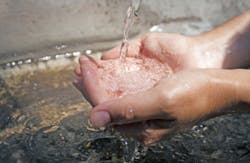Municipal water distribution systems can be largely exposed and therefore, vulnerable to intentional or accidental contamination. Past incidents illustrate possible future threats and reveal the many challenges faced by policymakers, emergency personnel, consequence management teams and the general public.
Threats to supplies
In 1993, for instance, the city of Milwaukee, Wisconsin, suffered an outbreak of a protozoan parasite, Cryptosporidium parvum, which caused up to perhaps 400,000 residents to become ill and resulted in several deaths. Milwaukee is served by two facilities that draw water from Lake Michigan and use traditional water treatment processes.
When heavy rains fell during spring, Lake Michigan experienced increased turbidity. The introduction of polyaluminum chloride (PACI) was being tested for use in that facility. Storm sewer discharges exacerbated the water quality problem. Some believe the issues had probably been occurring periodically but not noticed, until experimenting with introduction of the PACI reduced the filtration performance at the plant.
Ultimately, a design flaw and a change in water purification for turbidity reduction likely contributed to the outbreak of Cryptosporidium parvum. Yet, this incident offers two additional insights. First, proper water treatment chemicals are critical. Second, an increased reliance on automation means that computers control chemical releases.
According to the Centers for Disease Control and Prevention (CDC), there were 33 reported waterborne disease outbreaks out of well over 55,000 water supplies in 2009-2010: Five giardiasis outbreaks with 67 cases, and two with 44 cases of cryptosporidiosis from drinking waters or recreational waters. So, protozoa and other microbes are now a minor issue except for legionella.
Although some water treatment facilities now use a dual-line water system with motorized, RF-controlled valves, these systems can be hacked remotely. In November 2011, a Stuxnet-style virus infected a water plant in Springfield, Illinois, and shut down water pumps, proving secure networks can be breached and physical equipment compromised.
Many observers believe physical destruction of water system components and the disruption of water supplies are more likely scenarios than contamination. Other potential scenarios include damage to vital equipment by explosives or hacking into supervisory control and data acquisition (SCADA) systems.
The presence of returned pharmaceuticals can also contaminate water supplies. Current urban filtration systems are not designed to remove over-the-counter (OTC) and prescription drugs from water supplies, and increased estrogen levels may affect both marine life and human health. Although most chem-bio agents dilute and disassociate in water, some maintain their chemical structure over an extended period of time. Along with the contaminants described in the incidents above, potable water that is compromised can also be contaminated by: Metals (As, Hg, Cr, Pb, etc.); radionuclides; organic chemicals/compounds (trichloroethylene [TCE], acetone, styrene, household degreasers, halogenated organics, etc.); VOCs; disinfectants and byproducts; dyes; organic biocides and crude oil; and pesticides.
Threat identification
Vulnerability assessments and emergency response plans are required. Monitoring is required for regulated and some unregulated contaminants. Many types of disruptions in water treatment plants are readily detectable by online monitoring of turbidity, disinfectant demand, taste and odor.
The ability to identify and prioritize contaminants determines how well we can sense, detect, isolate and mitigate threats to water supplies. In the U.S., the National Infrastructure Protection Center (NIPC) and the Critical Infrastructure Protection Advisory Group (CIPAG) play important roles.
Established in 1998 by Presidential Decision Directive (PDD) 63, NIPC gives the U.S. Environmental Protection Agency (EPA) the lead on protecting water supplies. CIPAG is composed of industry representatives and supported by water associations and federal agencies such as the EPA, FBI and Department of Energy (DOE).
CIPAG’s responsibilities include the Information Sharing and Analysis Center (ISAC) for the secure transmission of threat information and other sensitive data. Available resources include the Vulnerability Self-Assessment Tool (VSAT), which helps owners of drinking water and wastewater systems to analyze security threats, assess natural hazards and update their emergency response plans.
Planning and public policy
Other resources to safeguard against potential threats are also available. For example, the Water Contamination Information Tool (WCIT) is a secure, online EPA database that helps with emergency response plans and site-specific response guidelines. WCIT can provide real-time data on water contaminants and assist in decision-making if contamination occurs.
The Water Health and Economic Analysis Tool (WHEAT) helps quantify human health and economic consequences for various scenarios posing significant risks to water supplies. WHEAT supplements expert risk assessment and analyzes two types of scenarios: The loss of one or more assets and the release of a stored hazardous gas.
By examining past incidents and planning for possible future scenarios, policymakers and emergency personnel can join consequence management teams and the general public in facing any potential threats to municipal water supplies.
Steve Melito is an award-winning content developer specializing in manufacturing, material science and homeland security.
